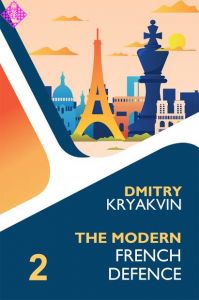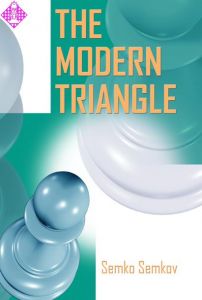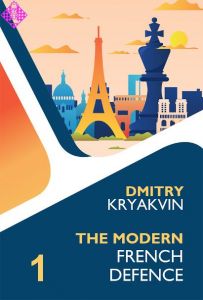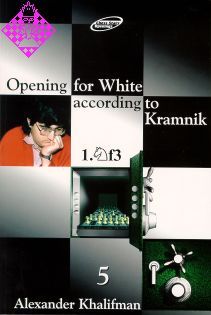Artikelnummer
LOKHA1SF3V
Autor
1.Nf3 - Opening for White according to Kramnik - 5
271 Seiten, kartoniert, Chess Stars, 2002
Aus der Reihe »Chess Stars Openings«
Final vergriffen
Preface
Dear Chessfriends
In the last book of a series "Opening for White according to Kramnik" the question will be in what ways White can struggle for an advantage in the Queen's Gambit Decline (QGD). In contradistinction to previous four books the fifth volume includes only one opening. There is nothing surprising in it. The point is that the Queen's Gambit Declined is one of the oldest openings belonging to the closed ones. Its history has more than one hundred years. For this long period huge practical material was accumulated. Suffice it to say that all world champions played this opening for both the colours.
The structure of the Queen's Gambit Declined is various and dissimilar. In the first part of the book we will examine such lines where Black refuses from the move 3...Ng8-f6. There are different reasons for it: Black can try to simplify the play by 3...Bb4+ or he can start building "a stone wall" with the help of 3.. .f5, or by means of 3...c6 to begin attacking White's c4-pawn. A lot of typical positions, arising after 3...c5, lead to the Tarrasch Defense. In it Black has to pay with d5-pawn's isolation for rather a simple solution to the problem of developing his light-squares bishop.
In the second part we will examine lines in which after 1.Nf3 d5 2.d4 e6 3.c4 Nf6 4.Nc3 Black refuses from the move 4..Be7. In these variants Black is going to create a counterplay literally from the very beginning. As a rule, the play of both the opponents is very concrete here. Quite often White has to make some material sacrifices to obtain an opening advantage as, for instance, in Vienna Variation (4...dxc4 5.e4) or in Semi-Tarrasch Defense (4...c5). The play in variation 4...Nbd7 5.Bg5 Bb4 is also very dynamic, as well as in the variant with move 4... Bb4.
The third part of the book is entirely devoted to classical variants of the Queen's Gambit with 4... Be7. In most cases the play has calm character here, in contradistinction to the variants of the second part. The opponents begin active actions only after mobilization of the majority of their pieces. That is why it is no wonder that the theory of such branches of the Queen's Gambit as the Capablanca and Lasker's Defence, Orthodox Variation, etc. is studied for the tens moves ahead. The chapter devoted to the Tartakower Defense concludes the third part. It is possible to say without exaggeration that it is one of the most popular modern systems of the Queen's Gambit. V.Kramnik has this system in his opening repertoire for both colours and its theory is constantly updated by new ideas.
A.Khalifman, 14th World Chess Champion
Dear Chessfriends
In the last book of a series "Opening for White according to Kramnik" the question will be in what ways White can struggle for an advantage in the Queen's Gambit Decline (QGD). In contradistinction to previous four books the fifth volume includes only one opening. There is nothing surprising in it. The point is that the Queen's Gambit Declined is one of the oldest openings belonging to the closed ones. Its history has more than one hundred years. For this long period huge practical material was accumulated. Suffice it to say that all world champions played this opening for both the colours.
The structure of the Queen's Gambit Declined is various and dissimilar. In the first part of the book we will examine such lines where Black refuses from the move 3...Ng8-f6. There are different reasons for it: Black can try to simplify the play by 3...Bb4+ or he can start building "a stone wall" with the help of 3.. .f5, or by means of 3...c6 to begin attacking White's c4-pawn. A lot of typical positions, arising after 3...c5, lead to the Tarrasch Defense. In it Black has to pay with d5-pawn's isolation for rather a simple solution to the problem of developing his light-squares bishop.
In the second part we will examine lines in which after 1.Nf3 d5 2.d4 e6 3.c4 Nf6 4.Nc3 Black refuses from the move 4..Be7. In these variants Black is going to create a counterplay literally from the very beginning. As a rule, the play of both the opponents is very concrete here. Quite often White has to make some material sacrifices to obtain an opening advantage as, for instance, in Vienna Variation (4...dxc4 5.e4) or in Semi-Tarrasch Defense (4...c5). The play in variation 4...Nbd7 5.Bg5 Bb4 is also very dynamic, as well as in the variant with move 4... Bb4.
The third part of the book is entirely devoted to classical variants of the Queen's Gambit with 4... Be7. In most cases the play has calm character here, in contradistinction to the variants of the second part. The opponents begin active actions only after mobilization of the majority of their pieces. That is why it is no wonder that the theory of such branches of the Queen's Gambit as the Capablanca and Lasker's Defence, Orthodox Variation, etc. is studied for the tens moves ahead. The chapter devoted to the Tartakower Defense concludes the third part. It is possible to say without exaggeration that it is one of the most popular modern systems of the Queen's Gambit. V.Kramnik has this system in his opening repertoire for both colours and its theory is constantly updated by new ideas.
A.Khalifman, 14th World Chess Champion
| EAN | 9548782243 |
|---|---|
| Gewicht | 350 g |
| Hersteller | Chess Stars |
| Breite | 14,5 cm |
| Höhe | 21 cm |
| Medium | Buch |
| Erscheinungsjahr | 2002 |
| Autor | Alexander Khalifman |
| Reihe | Chess Stars Openings |
| Sprache | Englisch |
| ISBN-10 | 9548782243 |
| Seiten | 271 |
| Einband | kartoniert |
| Name | Chess Stars |
|---|---|
| Adresse | Complex "Geo Milev" BL. 248 Ap. 47 Sofia 1113 Bulgarien |
| Internet | www.chess-stars.com |
| semkov@chess-stars.com |
Contents
007 Preface
Part 1. QGD without 3...Sf6
1.Sf3 d5 2.d4 e6 3.c4
011 1 3... Lb4 4.Ld2 Ld2 5.Sbd2 Sf6
015 2 3... f5 4.Lf4 Sf6
020 3 3... c6 4.Dc2 Sf6
040 4 3... c5 4.cd ed 5.Sc3 Sc6 6.g3 Sf6 (6...cd; 6...c4) 7.Lg2 Le7 (7...c4; 7...Le6; 7...Lg4; 7...cd) 8.0-0 0-0 (8...Le6) 9.Lg5 various
069 5 3... c5 4.cd ed 5.Sc3 Sc6 6.g3 Sf6 7.Lg2 Le7 8.0-0 0-0 9.Lg5 cd
Part 2. QGD without 4....Le7
1.Sf3 d5 2.d4 e6 3.c4 Sf6 4.Sc3
080 6 4... Sbd7 5.Lg5 Lb4; 5..h6
087 7 4... Lb4 5.cd ed 6.Lg5 h6 7.Lh4 c5; 7... g5
091 8 4... dc 5.e4 Lb4 6.Lg5 c5 (6...b5) 7.Lc4 cd 8.Sd4 various
105 9 4... dc 5.e4 Lb4 6.Lg5 c5 7.Lc4 cd 8.Sd4 Lc3
113 10 4... c5 5.cd Sd5 (5...cd) 6.e4 Sc3 7.bc cd 8.ed Lb4 (8..Sc6) 9.Ld2 Ld2 10.Dd2 0-0 11.Lc4 Sc6 (11...b6; 11...Sd7) 12.0-0 b6 13.Tad1 Lb7 14.Tfe1 Tc8 15.d5 ed
135 11 4... c5 5.cd Sd5 6.e4 Sc3 7.bc cd 8.ed Lb4 9.Ld2 Ld2 10.Dd2 0-0 11.Lc4 Sc6 12.0-0 b6 13.Tad1 Lb7 14.Tfe1 Tc8 15.d5 Sa5
Part 3. QGD. Classical Variation
1.Sf3 d5 2.d4 e6 3.c4 Sf6 4.Sc3 Le7 5.Lg5
143 12 5... dc; 5... h6; 5... Sbd7
155 13 5... 0-0 6.e3 Sbd7 (6...a6) 7.Tc1 various
187 14 5... 0-0 6.e3 Sbd7 7.Tc1 c6
208 15 5... 0-0 6.e3 h6 7.Lh4 Sbd7 (7...Se4) 8.Tc1 various
239 16 5... 0-0 6.e3 h6 7.Lh4 Sbd7 8.Tc1 c6
253 17 5... 0-0 6.e3 h6 7.Lh4 b6
268 Index of Variations
007 Preface
Part 1. QGD without 3...Sf6
1.Sf3 d5 2.d4 e6 3.c4
011 1 3... Lb4 4.Ld2 Ld2 5.Sbd2 Sf6
015 2 3... f5 4.Lf4 Sf6
020 3 3... c6 4.Dc2 Sf6
040 4 3... c5 4.cd ed 5.Sc3 Sc6 6.g3 Sf6 (6...cd; 6...c4) 7.Lg2 Le7 (7...c4; 7...Le6; 7...Lg4; 7...cd) 8.0-0 0-0 (8...Le6) 9.Lg5 various
069 5 3... c5 4.cd ed 5.Sc3 Sc6 6.g3 Sf6 7.Lg2 Le7 8.0-0 0-0 9.Lg5 cd
Part 2. QGD without 4....Le7
1.Sf3 d5 2.d4 e6 3.c4 Sf6 4.Sc3
080 6 4... Sbd7 5.Lg5 Lb4; 5..h6
087 7 4... Lb4 5.cd ed 6.Lg5 h6 7.Lh4 c5; 7... g5
091 8 4... dc 5.e4 Lb4 6.Lg5 c5 (6...b5) 7.Lc4 cd 8.Sd4 various
105 9 4... dc 5.e4 Lb4 6.Lg5 c5 7.Lc4 cd 8.Sd4 Lc3
113 10 4... c5 5.cd Sd5 (5...cd) 6.e4 Sc3 7.bc cd 8.ed Lb4 (8..Sc6) 9.Ld2 Ld2 10.Dd2 0-0 11.Lc4 Sc6 (11...b6; 11...Sd7) 12.0-0 b6 13.Tad1 Lb7 14.Tfe1 Tc8 15.d5 ed
135 11 4... c5 5.cd Sd5 6.e4 Sc3 7.bc cd 8.ed Lb4 9.Ld2 Ld2 10.Dd2 0-0 11.Lc4 Sc6 12.0-0 b6 13.Tad1 Lb7 14.Tfe1 Tc8 15.d5 Sa5
Part 3. QGD. Classical Variation
1.Sf3 d5 2.d4 e6 3.c4 Sf6 4.Sc3 Le7 5.Lg5
143 12 5... dc; 5... h6; 5... Sbd7
155 13 5... 0-0 6.e3 Sbd7 (6...a6) 7.Tc1 various
187 14 5... 0-0 6.e3 Sbd7 7.Tc1 c6
208 15 5... 0-0 6.e3 h6 7.Lh4 Sbd7 (7...Se4) 8.Tc1 various
239 16 5... 0-0 6.e3 h6 7.Lh4 Sbd7 8.Tc1 c6
253 17 5... 0-0 6.e3 h6 7.Lh4 b6
268 Index of Variations
Diese umfangreiche Serie ist der König der Repertoirewerke. Aus der Ecke Khalifman/Soloview (Hrsg.) ist schon einiges erschienen, das meiste waren aber doch nur bessere Datenbankausdrucke wie z. B. eine vierbändige Serie über das Schaffen von Tal. Man darf bezweifeln, dass der frühere Fide-WM alles allein geschrieben hat. Aber wenn hier Ghostwriter am Werke waren, dann gewiss Hochkaräter aus der St. Petersburger Schule.
Zunächst beschreibt das Werk ein 1. Sf3-Repertoire, jedoch mit zahlreichen Überleitungen zu 1. d4-Eröffnungen. So wird Königsindisch „prinzipiell" angegangen, auch Holländisch oder das Damengambit; gegen Grünfeld- oder Nimzoindisch weicht man auf Flankenvarianten (ohne d2-d4) aus, vor Wolga und Modernem Benoni „drückt" man sich ganz. Im Gegenzug muss man - im Unterschied zum 1. d4-Spieler - etliche Varianten des symmetrischen Englisch beherrschen (1. Sf3 c5 2. c4), selbst um Übergänge zu 1. e4 kommt man nicht herum, insbesondere den Maroczy-Aufbau gegen Sizilianisch. Ob das vorgestellte Repertoire so ganz Kramnik-kongruent ist, sei dahingestellt. Immerhin, viele technisch orientierte Spieler pflegen ein ähnliches.
Stellen wir kurz die einzelnen Bände vor.
Band 1, Schwerpunkt Königsindisch, der klassische Sf3/Le2-Aufbau mit 7. 0-0 und 9. b4, und selbst wenn man diese Modevariante nicht spielt (sondern 9. Se1 oder 9. Sd2), kommt man dank der Abhandlung der zahlreichen Nebenvarianten, z. B. 6. ... c6,6. ... Lg4, 7. ... Sa6, 7. ... Sbd7, 7. ... e:d4 auf seine Kosten, man erhält jeweils klare Spielrezepte. Ferner Altindisch sowie - etwas strittig - Anti-Grünfeld mit 1. Sf3 Sf6 2. c4 g6 3. Sc3 d5 4. c:d5 S:d5 5. e4 oder 5. Wa4+. Kramnik hat beides schon gespielt, zuletzt aber eher der prinzipiellen Hauptvariante den Vorzug gegeben. Es bleibt mit Blick auf das Gesamtwerk unlogisch, dass man Grünfeld-Indisch nur mit einer etwas dünnen Nebenvariante abhandelt.
Band 2 enthält Nimzo- und Damenindische Variationen (1. Sf3 Sf6 2. c4 e6 3. Sc3 Lb4 4. Dc2 und dgl.), den Englisch-Igel (A 30) mit 7. Te1 fiel sowie verschiedene Varianten des Symmetrie-Englisch nach 1. Sf3 Sf6 2. c4 c5. Der Band sei auch den 1. c4-Spielern ans Herz gelegt!
Band 3 zeigt das Maroczy-System, ein paar weitere Englisch-Varianten, 1. ... g6 (weißes Vollzentrum mit e4/d4/c4) und Holländisch.
Band 4 (Slawisch) ist nach einer kleinen Fahrplanänderung noch nicht erschienen, dafür aber Band 5 mit verschiedenen Damengambit-Versionen (Angenommen, Tarrasch, Semi-Tarrasch, Orthodox). Nach 1. Sf3 d5 setzt der Repertoire-Spieler nämlich mit 2. d4 nebst 3. c4 fort. Nicht mit 2. c4, z. B. wegen 2. ... d4. Das ganze Reti-System - im allgemeinen Bewusstsein doch an erster Stelle mit dem Zug 1. Sf3 verknüpft - bleibt ausgeklammert. Das Thema Damengambit scheint mir freilich einen übergroßen Stellenwert einzunehmen; vielleicht hätte Katalanisch besser in das Gesamtkonzept gepasst.
Insgesamt ist das Repertoire extrem fein differenziert, Khalifman zeigt jeweils eine haargenau passende Zugfolge. So ist ein Stonewall mit Le7 (oft möglich durch nachträgliches Sf6-e4 und f7-f5) grundsätzlich willkommen, ein Stonewall mit Ld6 jedoch nicht. In diesem Fall weicht Weiß auf den Plan d2-d3 und e2-e4 aus. Um alle Nuancen nutzen zu können, muss man jedoch ziemlich viele verschiedene Stellungen spielen (zumindest, wenn man „perfekt" dem Rezept folgen will), darum ist das Werk auch so umfangreich geworden.
Note 1 also für ein wichtiges Eröffnungsbuchkriterium, die Zugfolgenpräzision. Ebenfalls gut die Auswahl der Varianten und des Illustrationsmaterials. Gerade zu etwas schwächeren, aber turnierpraktisch häufigen Behandlungen von Schwarz findet sich ausführliches Material, die meisten Eröffnungsbücher greifen in dieser Hinsicht zu kurz. Ein Schwachpunkt ist die mangelnde Originalanalyse, in theoretischer Hinsicht wird meist Standardwissen präsentiert. Gut ausgewähltes und erläutertes Standardwissen freilich. Die Erklärungen sind aus Sicht eines einigermaßen starken Tumierspielers eingängig. Nichtsdestotrotz, das gesamte Repertoire ist ziemlich anspruchsvoll; sehr häufig erhält man technische Stellungen mit einem subtilen Vorteil, und es bedarf schon einer gewissen Spielstärke (und eines gewissen Stils), um damit etwas anfangen zu können.
Der Preis orientiert sich am englischen Niveau, der Produktionsstandard leider nicht ganz. So gibt es einige Variantenwüsten, die man mit Absätzen, Fett-und Kursivdruck hätte strukturieren sollen. Sowie gelegentliche Notationsfehler, obgleich die Arbeit ansonsten hervorragend organisiert ist! Schriftbild Mittelklasse, Papier ebenso, Ausländerenglisch. Insgesamt in diesen Punkten deutlich unterhalb Westniveau, aber klar oberhalb östlicher Billigproduktionen. Das ganze Repertoire scheint sehr zukunftssicher, nur an wenigen aktuellen Varianten wird man ständig feilen müssen. Diese Serie kann das (Weiß-)Spiel eines jüngeren Spielers mit Meisterambitioner auf lange Zeit prägen!
Harald Keilhack in Schach 01/2003
Zunächst beschreibt das Werk ein 1. Sf3-Repertoire, jedoch mit zahlreichen Überleitungen zu 1. d4-Eröffnungen. So wird Königsindisch „prinzipiell" angegangen, auch Holländisch oder das Damengambit; gegen Grünfeld- oder Nimzoindisch weicht man auf Flankenvarianten (ohne d2-d4) aus, vor Wolga und Modernem Benoni „drückt" man sich ganz. Im Gegenzug muss man - im Unterschied zum 1. d4-Spieler - etliche Varianten des symmetrischen Englisch beherrschen (1. Sf3 c5 2. c4), selbst um Übergänge zu 1. e4 kommt man nicht herum, insbesondere den Maroczy-Aufbau gegen Sizilianisch. Ob das vorgestellte Repertoire so ganz Kramnik-kongruent ist, sei dahingestellt. Immerhin, viele technisch orientierte Spieler pflegen ein ähnliches.
Stellen wir kurz die einzelnen Bände vor.
Band 1, Schwerpunkt Königsindisch, der klassische Sf3/Le2-Aufbau mit 7. 0-0 und 9. b4, und selbst wenn man diese Modevariante nicht spielt (sondern 9. Se1 oder 9. Sd2), kommt man dank der Abhandlung der zahlreichen Nebenvarianten, z. B. 6. ... c6,6. ... Lg4, 7. ... Sa6, 7. ... Sbd7, 7. ... e:d4 auf seine Kosten, man erhält jeweils klare Spielrezepte. Ferner Altindisch sowie - etwas strittig - Anti-Grünfeld mit 1. Sf3 Sf6 2. c4 g6 3. Sc3 d5 4. c:d5 S:d5 5. e4 oder 5. Wa4+. Kramnik hat beides schon gespielt, zuletzt aber eher der prinzipiellen Hauptvariante den Vorzug gegeben. Es bleibt mit Blick auf das Gesamtwerk unlogisch, dass man Grünfeld-Indisch nur mit einer etwas dünnen Nebenvariante abhandelt.
Band 2 enthält Nimzo- und Damenindische Variationen (1. Sf3 Sf6 2. c4 e6 3. Sc3 Lb4 4. Dc2 und dgl.), den Englisch-Igel (A 30) mit 7. Te1 fiel sowie verschiedene Varianten des Symmetrie-Englisch nach 1. Sf3 Sf6 2. c4 c5. Der Band sei auch den 1. c4-Spielern ans Herz gelegt!
Band 3 zeigt das Maroczy-System, ein paar weitere Englisch-Varianten, 1. ... g6 (weißes Vollzentrum mit e4/d4/c4) und Holländisch.
Band 4 (Slawisch) ist nach einer kleinen Fahrplanänderung noch nicht erschienen, dafür aber Band 5 mit verschiedenen Damengambit-Versionen (Angenommen, Tarrasch, Semi-Tarrasch, Orthodox). Nach 1. Sf3 d5 setzt der Repertoire-Spieler nämlich mit 2. d4 nebst 3. c4 fort. Nicht mit 2. c4, z. B. wegen 2. ... d4. Das ganze Reti-System - im allgemeinen Bewusstsein doch an erster Stelle mit dem Zug 1. Sf3 verknüpft - bleibt ausgeklammert. Das Thema Damengambit scheint mir freilich einen übergroßen Stellenwert einzunehmen; vielleicht hätte Katalanisch besser in das Gesamtkonzept gepasst.
Insgesamt ist das Repertoire extrem fein differenziert, Khalifman zeigt jeweils eine haargenau passende Zugfolge. So ist ein Stonewall mit Le7 (oft möglich durch nachträgliches Sf6-e4 und f7-f5) grundsätzlich willkommen, ein Stonewall mit Ld6 jedoch nicht. In diesem Fall weicht Weiß auf den Plan d2-d3 und e2-e4 aus. Um alle Nuancen nutzen zu können, muss man jedoch ziemlich viele verschiedene Stellungen spielen (zumindest, wenn man „perfekt" dem Rezept folgen will), darum ist das Werk auch so umfangreich geworden.
Note 1 also für ein wichtiges Eröffnungsbuchkriterium, die Zugfolgenpräzision. Ebenfalls gut die Auswahl der Varianten und des Illustrationsmaterials. Gerade zu etwas schwächeren, aber turnierpraktisch häufigen Behandlungen von Schwarz findet sich ausführliches Material, die meisten Eröffnungsbücher greifen in dieser Hinsicht zu kurz. Ein Schwachpunkt ist die mangelnde Originalanalyse, in theoretischer Hinsicht wird meist Standardwissen präsentiert. Gut ausgewähltes und erläutertes Standardwissen freilich. Die Erklärungen sind aus Sicht eines einigermaßen starken Tumierspielers eingängig. Nichtsdestotrotz, das gesamte Repertoire ist ziemlich anspruchsvoll; sehr häufig erhält man technische Stellungen mit einem subtilen Vorteil, und es bedarf schon einer gewissen Spielstärke (und eines gewissen Stils), um damit etwas anfangen zu können.
Der Preis orientiert sich am englischen Niveau, der Produktionsstandard leider nicht ganz. So gibt es einige Variantenwüsten, die man mit Absätzen, Fett-und Kursivdruck hätte strukturieren sollen. Sowie gelegentliche Notationsfehler, obgleich die Arbeit ansonsten hervorragend organisiert ist! Schriftbild Mittelklasse, Papier ebenso, Ausländerenglisch. Insgesamt in diesen Punkten deutlich unterhalb Westniveau, aber klar oberhalb östlicher Billigproduktionen. Das ganze Repertoire scheint sehr zukunftssicher, nur an wenigen aktuellen Varianten wird man ständig feilen müssen. Diese Serie kann das (Weiß-)Spiel eines jüngeren Spielers mit Meisterambitioner auf lange Zeit prägen!
Harald Keilhack in Schach 01/2003
Mehr von Chess Stars
-
 The Modern French vol. 1 + 239,90 €
The Modern French vol. 1 + 239,90 € -
 The Modern French vol. 221,95 €
The Modern French vol. 221,95 € -
 The Modern Triangle19,95 €
The Modern Triangle19,95 € -
 The Modern French vol. 121,95 €
The Modern French vol. 121,95 € -
 Attacking 1…d5 - vol. 1+239,90 €
Attacking 1…d5 - vol. 1+239,90 € - Mehr von Chess Stars



